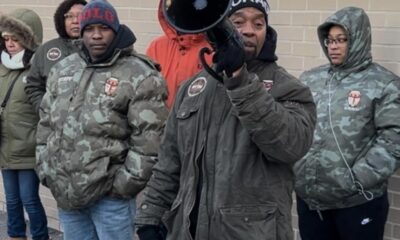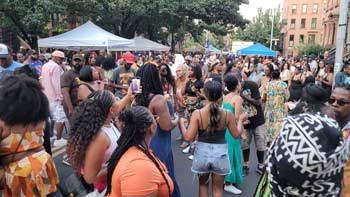City Politics
Where to Count Prisoners Leads Concerns at Congressional Hearing on Census
Issue Impact Redistricting and Federal Funds
Where prisoners are counted as living determines both electoral districts as well as how many federal dollars are available for everything from job creation to food stamps and other human needs. With 75% of prisoners in upstate New York coming from seven zip codes in New York City, it was an area of special concern at the congressional hearing of The Information Policy, Census and National Archives Subcommittee held at Brooklyn’s Borough Hall this past Monday.

Witnesses on Census couting of group quarters and readiness: Census Director Dr. Robert Groves; Robert Goldenkoff, Director of Strategic Issues for the Government Accountability Office; Peter Wagner, Executive Director of the Prison Policy Initiative; Mr. Thomas Ellet, Associate Vice President of Student Affairs at New York University. Photo: Mark Stewart
The hearing on Group Quarters such as prisons, schools and nursing homes, chaired by Congressman William Lacy Clay, Jr. and held jointly with the Committee on Oversight and Government Reform, chaired by Congressman Ed Towns, took testimony from Census Director Dr. Robert Groves that since 1790, the United States Census Bureau has counted people using the usual Residency Rule, i.e., where they eat, sleep and live most of the time.
Peter Wagner, Executive Director of the Prison Policy Initiative, had a startling statistic: the 2.3 million people incarcerated is larger than the population of 15 states. “Some districts are 80-90% prisoners” he told the committee. The Web site for the Initiative says that “In New York State, for example, one out of every three people who moved to upstate New York in the 1990s actually ‘moved’ into a newly constructed prison. The state bars people in prison from voting, but their presence in the Census boosts the population of the upstate districts whose legislators favor prison expansion. Without this phantom population, seven upstate New York Senate districts would not meet minimum population requirements and would have to be redrawn.”
Currently, with prisoners included as residents of the county where they are incarcerated, rather than where they came from, the federal dollars for social services based on population are sent to counties where the prisons are located, even though the prisoners don’t use any local services and the counties where the prisoners come from, usually high-need areas, lose the dollars earmarked to provide them with services.
They can’t do an individual count/interview because of the security. The bureau depends on administrative records to count the prisoners. In later testimony, Mr. Thomas Ellet, Associate Vice President of Student Affairs at New York University, said that in terms of the accuracy of administrative records, the quality varies across systems, “particularly in prisons.”
Wagner later reminded the congressmen that legally speaking the prisoners have not left their homes. Here he was referring to the NY Constitution which says that “no person shall be deemed to have gained or lost a residence by reason of his presence or absence … while confined in any public prison.” And he said that the legislature can do something this year to include the prisoners in the count of their home addresses.
The bureau is taking the position that the Census is not proposing to change where people are counted, and are leaving it up to the states to determine how that count will be used in the reapportionment process, where political districts are drawn to contain the same number of people in order to adhere to a federally-mandated “one man, one vote” standard. Dr. Groves agreed with Chairman Clay that he was glad not to be a part of the redistricting process. According to Senator Velmanette Montgomery’s office, a Bill in the NYS Senate is due to be proposed momentarily.
Chairman Towns asked Robert Goldenkoff, Director of Strategic Issues for the Government Accountability Office, about the technological readiness of the Census Bureau for the April 1st start date. Goldenkoff divided the problems into categories. First: People, the technicians are falling behind schedule and can’t take away the time from doing the work to train new people. Second was Hardware: the Census computers are simply outdated. Third was Software, where defects are continuing to mount and of course four, the Schedule. The operation has a fixed date (April 1st.) when the system must be ready. He acknowledged that the Bureau has gained some time by scaling back from the full-blown version as originally envisioned, but said that even at the reduced level, the bureau remains challenged to hit the April 1st mark.
 Looking to improve the job the Census does in traditionally undercounted areas such as Bedford-Stuyvesant, Chairman Towns asked Dr. Groves if the discretionary funds the Bureau has could be used to target areas such as Kings County that have been traditionally undercounted in the past. “We need to get the information out to the people, using local news and local press.” Dr. Groves responded that they were advertising to the grassroots level, using community newspapers. [ Publisher’s Note: we haven’t gotten any.] As for the discretionary funds, Dr. Groves said that response rates to the mailing were being analyzed and areas that appeared to be undercounted will be the target for the discretionary funds.
Looking to improve the job the Census does in traditionally undercounted areas such as Bedford-Stuyvesant, Chairman Towns asked Dr. Groves if the discretionary funds the Bureau has could be used to target areas such as Kings County that have been traditionally undercounted in the past. “We need to get the information out to the people, using local news and local press.” Dr. Groves responded that they were advertising to the grassroots level, using community newspapers. [ Publisher’s Note: we haven’t gotten any.] As for the discretionary funds, Dr. Groves said that response rates to the mailing were being analyzed and areas that appeared to be undercounted will be the target for the discretionary funds.













